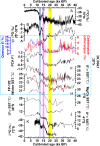Asynchronous marine-terrestrial signals of the last deglacial warming in East Asia associated with low- and high-latitude climate changes
- PMID: 23720306
- PMCID: PMC3683759
- DOI: 10.1073/pnas.1300025110
Asynchronous marine-terrestrial signals of the last deglacial warming in East Asia associated with low- and high-latitude climate changes
Abstract
A high-resolution multiproxy record, including pollen, foraminifera, and alkenone paleothermometry, obtained from a single core (DG9603) from the Okinawa Trough, East China Sea (ECS), provided unambiguous evidence for asynchronous climate change between the land and ocean over the past 40 ka. On land, the deglacial stage was characterized by rapid warming, as reflected by paleovegetation, and it began ca. 15 kaBP, consistent with the timing of the last deglacial warming in Greenland. However, sea surface temperature estimates from foraminifera and alkenone paleothermometry increased around 20-19 kaBP, as in the Western Pacific Warm Pool (WPWP). Sea surface temperatures in the Okinawa Trough were influenced mainly by heat transport from the tropical western Pacific Ocean by the Kuroshio Current, but the epicontinental vegetation of the ECS was influenced by atmospheric circulation linked to the northern high-latitude climate. Asynchronous terrestrial and marine signals of the last deglacial warming in East Asia were thus clearly related to ocean currents and atmospheric circulation. We argue that (i) early warming seawater of the WPWP, driven by low-latitude insolation and trade winds, moved northward via the Kuroshio Current and triggered marine warming along the ECS around 20-19 kaBP similar to that in the WPWP, and (ii) an almost complete shutdown of the Atlantic Meridional Overturning Circulation ca. 18-15 kaBP was associated with cold Heinrich stadial-1 and delayed terrestrial warming during the last deglacial warming until ca. 15 kaBP at northern high latitudes, and hence in East Asia. Terrestrial deglacial warming therefore lagged behind marine changes by ca. 3-4 ka.
Keywords: East Asian monsoon; asynchrony; land-sea correlation; low- and high-latitude interplay; thermohaline circulation.
Conflict of interest statement
The authors declare no conflict of interest.
Figures



Similar articles
-
Impact of abrupt deglacial climate change on tropical Atlantic subsurface temperatures.Proc Natl Acad Sci U S A. 2012 Sep 4;109(36):14348-52. doi: 10.1073/pnas.1207806109. Epub 2012 Aug 20. Proc Natl Acad Sci U S A. 2012. PMID: 22908256 Free PMC article.
-
Abrupt pre-Bølling-Allerød warming and circulation changes in the deep ocean.Nature. 2014 Jul 3;511(7507):75-8. doi: 10.1038/nature13472. Nature. 2014. PMID: 24990748
-
Onset of deglacial warming in West Antarctica driven by local orbital forcing.Nature. 2013 Aug 22;500(7463):440-4. doi: 10.1038/nature12376. Epub 2013 Aug 14. Nature. 2013. PMID: 23945585
-
Pollen from the Deep-Sea: A Breakthrough in the Mystery of the Ice Ages.Front Plant Sci. 2018 Jan 26;9:38. doi: 10.3389/fpls.2018.00038. eCollection 2018. Front Plant Sci. 2018. PMID: 29434616 Free PMC article. Review.
-
Climate change and Southern Ocean ecosystems I: how changes in physical habitats directly affect marine biota.Glob Chang Biol. 2014 Oct;20(10):3004-25. doi: 10.1111/gcb.12623. Epub 2014 Jun 30. Glob Chang Biol. 2014. PMID: 24802817 Review.
Cited by
-
Morphological diversity of Quercus fossil pollen in the northern South China Sea during the last glacial maximum and its paleoclimatic implication.PLoS One. 2018 Oct 12;13(10):e0205246. doi: 10.1371/journal.pone.0205246. eCollection 2018. PLoS One. 2018. PMID: 30312322 Free PMC article.
-
Fast response of vegetation in East Asia to abrupt climatic events during the last deglaciation.PNAS Nexus. 2023 Feb 27;2(3):pgad061. doi: 10.1093/pnasnexus/pgad061. eCollection 2023 Mar. PNAS Nexus. 2023. PMID: 37007712 Free PMC article.
-
Vegetation and Climate Change during the Last Deglaciation in the Great Khingan Mountain, Northeastern China.PLoS One. 2016 Jan 5;11(1):e0146261. doi: 10.1371/journal.pone.0146261. eCollection 2016. PLoS One. 2016. PMID: 26730966 Free PMC article.
References
-
- De Deckker P, Moros M, Perner K, Jansen E. Influence of the tropics and southern westerlies on glacial interhemispheric asymmetry. Nat Geosci. 2012;5(4):266–269.
-
- Jennerjahn TC, et al. Asynchronous terrestrial and marine signals of climate change during Heinrich events. Science. 2004;306(5705):2236–2239. - PubMed
-
- Barker S, et al. Interhemispheric Atlantic seesaw response during the last deglaciation. Nature. 2009;457(7233):1097–1102. - PubMed
-
- Clark PU, et al. The Last Glacial Maximum. Science. 2009;325(5941):710–714. - PubMed
-
- Kiefer T, Kienast M. Patterns of deglacial warming in the Pacific Ocean: A review with emphasis on the time interval of Heinrich event 1. Quat Sci Rev. 2005;24(7-9):1063–1081.
Publication types
MeSH terms
Substances
LinkOut - more resources
Full Text Sources
Other Literature Sources
Medical
Miscellaneous

